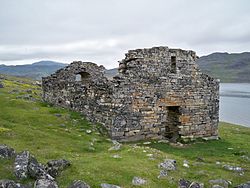This is an old revision of this page, as edited by MJCdetroit (talk | contribs) at 16:57, 2 January 2018 (Units). The present address (URL) is a permanent link to this revision, which may differ significantly from the current revision.
Revision as of 16:57, 2 January 2018 by MJCdetroit (talk | contribs) (Units)(diff) ← Previous revision | Latest revision (diff) | Newer revision → (diff) Church in Hvalsey, Greenland| Hvalsey Church | |
|---|---|
| Hvalsø Kirke | |
 | |
 | |
| 60°49′43″N 45°46′54″W / 60.828664°N 45.781656°W / 60.828664; -45.781656 | |
| Location | Hvalsey |
| Country | Greenland |
| Denomination | Roman Catholic |
| History | |
| Status | Ruins |
| Founded | 12th century |
| Specifications | |
| Length | 16 metres (52 ft 6 in) |
| Width | 8 metres (26 ft 3 in) |
| Administration | |
| Archdiocese | Greenland |
Hvalsey Church (Template:Lang-da) was a church in the abandoned Greenlandic Norse settlement of Hvalsey (now modern-day Qaqortoq). The best preserved Norse ruins in Greenland, the Church was also the location of the last written record of the Greenlandic Norse - a wedding in September 1408.
History
According to the sagas, the land around Hvalsey was claimed by Thorkell Farserk, a cousin or uncle of Erik the Red. Christianity arrived in Greenland around the year 1000 and churches began to be built in the country. It is thought that Hvalsey Church was built in the early 14th century, but archaeological finds hint that this was not the first church in this site. The church is mentioned in several late medieval documents as one of the 10-14 parish churches in the Eastern Settlement.
The Church hosted the wedding of Thorstein Olafsson and Sigrid Björnsdóttir on either 14 or 16 September 1408. The wedding was mentioned in letters from a priest at Garðar and by several Icelanders, and is the last written record of the Greenlandic Norse. The married couple later settled in Olafsson's native Iceland.
In the Eskimo tradition, there is a legend about Hvalsey. According this legend, there was open war between the Norse chief Ungortoq and the Eskimo leader K'aissape. The Eskimos made a massive attack on Hvalsey and burned down the Norse inside their houses, but Ungortoq escaped with his family. K'aissape conquered him after a long pursuit, which ended near Kap Farvel. However, according to archaeological studies, there is no sign of a conflagration.
The site is now part of a sheep farm.
Buildings
Hvalsey is located on a narrow strip of land at the head of a fjord, with the church situated around 70 metres from the water. The church is located in a classic Greenlandic Norse farmstead, with several additional adjacent buildings. The farmstead included a large building approximately 1,300 m² in size. It had eleven rooms, combining living quarters, an 8 by 5 metre banqueting hall and livestock pens. There were other livestock pens away from the main building, a horse enclosure for visitors to keep their horses, a storage building further up the hill and a warehouse at the edge of the water.
The dwelling was built on the top of an earlier building that dates back to the time of Erik the Red, and may have been Thorkell Farserk's home.
Architecture
Around 16 metres long and 8 metres wide, the church was constructed in the Anglo-Norwegian style of the early 13th century. The church held around 30–35 people, and was surrounded by a dyke marking the limits of the cemetery.
It was built from granite fieldstones. The stones are carefully laid and fitted. Some of the stones weigh between 4 and 5 tonnes, and some even more. Mortar was also used, but it is not known if it was used between the stones or only as plaster on the outside walls. The mortar was made from crushed shells so the church would have been white when built. Qaqortoq means "the white place", and the modern town of that name at the mouth of the fjord could have got its name by association with the church.
The walls are approximately 1.5 metres thick. It is thought that it had a turf-covered wooden roof. All doors and windows are constructed using lintels, except for one window in the eastern gable, which had an arch. The window openings are wider on the inside; a detail not found in Icelandic churches, but well known in early churches in Britain which may have been the source of this building type.
Thanks to the good build quality Hvalsey Church has resisted the elements better than other Norse structures in Greenland. Nevertheless, it has partly collapsed, mainly due to the fact that it was built over a graveyard. Graves were not removed before the construction and this caused the sinking of the foundation.
Gallery
-
 The church's arch window
The church's arch window
-
 Southern aspect of the church
Southern aspect of the church
-
 The Farmstead buildings
The Farmstead buildings
-
 The banquet hall
The banquet hall
-
 Nearby stables
Nearby stables
-
 The horse pen
The horse pen
References
- ^ "Hvalsey Church" Blue Ice Explorer
- ^ Kirsten A. Seaver (1996) The Frozen Echo: Greenland and the Exploration of North America, Ca. A.D. 1000-1500, Stanford University Press, p154
- Shelagh D. Grant (2010) Polar Imperative: A History of Arctic Sovereignty in North America, Douglas & McIntyre, p47
- Abandoned Colony in Greenland: Archaeologists Find Clues to Viking Mystery Der Spiegel, 13 January 2009